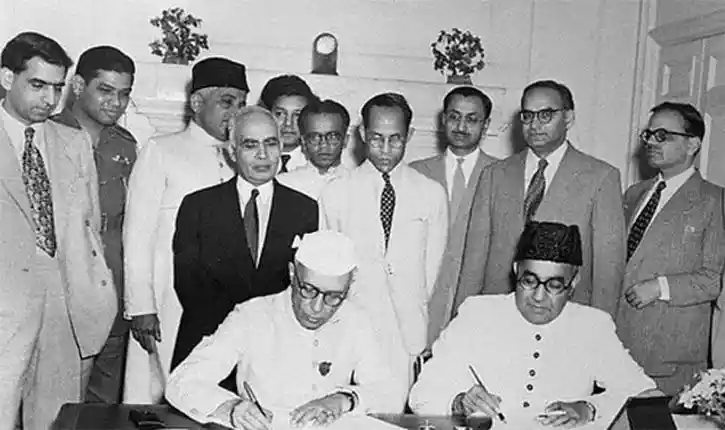The Jewel slipped away from the Crown
India's independence was a long-drawn process. British, who had ruled India for nearly two centuries weren't going to let go of their jewel so easily.

Prominent members of the first interim Government formed on September 2, 1946 led by Jawaharlal Nehru; Image Source: Ummid.com
When Britain entered World War II in 1939, under its Crown were several colonies, protectorates, and of course the Indian Empire. Britain was the single most powerful nation which controlled 25% of the total global population and 30% of its landmass.
The event which is generally seen as the beginning of the war was the German invasion of Poland on September 1, 1939. The British had given Germany an ultimatum to cease military operations, failing to adhere which would lead to an attack by the combined forces of Britain and France. Germany did not respond and two days later, on September 3, Britain and France declared war on Germany.
Britain’s declaration of war automatically meant the involvement of India and other Crown colonies and protectorates.
While the Statute of Westminster (1931) gave most colonies and protectorates the manner of choosing their dominion status, India was excluded, since the leaders of the Indian Independence Movement were fixed on their demand for nothing less but Poorna Swaraj (Complete Independence). And truth be told, neither did the British want to give any dominion status to India, for the Jewel that was the Indian Empire, had a different relationship with the Crown.
Ever since the transfer of power from Company to Crown in 1858, Britain had garrisoned nearly one-third of its army in India which was also paid for by India. From both military and economic standpoints, the British were reluctant to devolve any real power to Indians.
The Viceroy of India Linlithgow (1936-42) declared that India was at war against Germany without consulting any of the Indian politicians. The USA vouched for Indian independence and took an anti-colonial and anti-imperialist stand against Churchill. The involvement of India in World War II against its wishes made the call for its independence intensive from far and wide. In the war situation, Churchill was under tremendous pressure exerted by Roosevelt from the US and Chang Kai Shek from China, to achieve support from India.
Indians had understood that the support of Indian soldiers could not be compromised by the British. This revelation strengthened the demand for Indian independence. Even though there was support for the British from certain sections, some on the other hand went to the extent of siding with Germany and Japan (Indian National Army) to expel the British from India, while some like Nehru remained neutral. It was largely evident that in order for Indian support to continue in the war, it had to be given some incentives.
As a compensatory measure, the Cripps Mission was sent to India and the dominion status was declared sine qua non after the war. This time the Indians were not in the mood to settle for less than what they deserved. Congress rejected all the provisions of the Mission. Gandhi called it a ‘post-dated cheque’ and Nehru added ‘of a crashing bank’ to it.
As a result, the Quit India Movement was launched with full vigour in the backdrop of a defeated Europe which had been ravaged by wartime expenditure and treasuries sucked to their core.
The vibe of the Quit India Movement resonated with its famous slogan by Gandhi - DO OR DIE. Even though the British used full power to suppress the movement, Indians were successful.
By the end of 1945, negotiations for the transfer of power had begun.
As a way out of the existing stalemate and deadlock that prevailed in India between Indian leaders and the British Government, Lord Wavell introduced the Wavell Plan also known as the Breakdown Plan in June 1945. It was suggested that the Executive Council would be reconstituted and would be selected from leaders of Indian political life with a balanced representation of religious communities. The only exception was for the posts of Viceroy and Commander-in-Chief, which would continue to be held by the British.
Increasing pressure from people in Britain pushed the Government to speed up the process of India’s independence. The British Government was deep in wartime debt and simply could not afford to hold onto the Indian Empire any longer.
Once it was recognised that the British rule could not survive on the old basis for long, for a graceful withdrawal from India, the Cabinet Mission was sent in March 1946 to negotiate the setting up of a national Government and to set into motion a piece of machinery for transfer of power
Viceroy Wavell called upon the Indian representatives to form the interim Government on this day in 1946. Due to differences between the Muslim League and Congress, the former decided to boycott the government and the interim government was formed with Congress members alone with Nehru as the de facto head. This was a historical milestone in the struggle for India's independence, as for the first time, substantial power was transferred to the hands of Indians.
The interim government remained in power until October of the same year when Muslim League finally decided to fill in seats for the provinces they had won in.
The portfolios of the first interim Government formed on September 2, 1946, were as follows-
- Vice President of the Executive Council, External Affairs and Commonwealth Relations: Jawaharlal Nehru
- Home Affairs, Information and Broadcasting: Vallabhbhai Patel
- Agriculture and Food: Rajendra Prasad
- Arts, Education and Health: Shafaat Ahmed Khan
- Commerce: C.H. Bhabha
- Defence: Baldev Singh
- Finance: John Mathai
- Industries and Supplies: C. Rajagopalachari
- Labour: Jagjivan Ram
- Railways and Communications, Post and Air: Asaf Ali
- Work, Mines and Power: Sarat Bose


